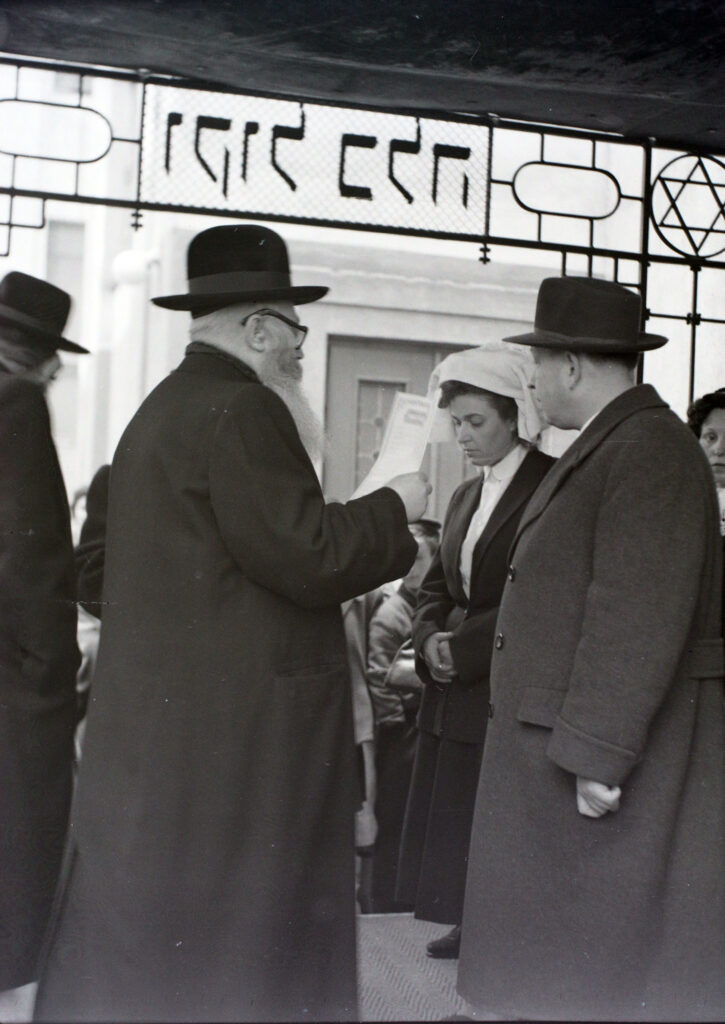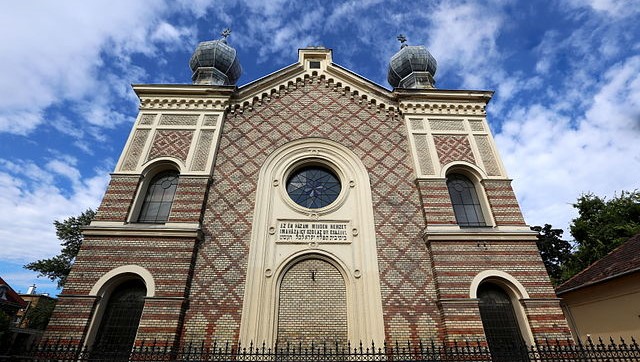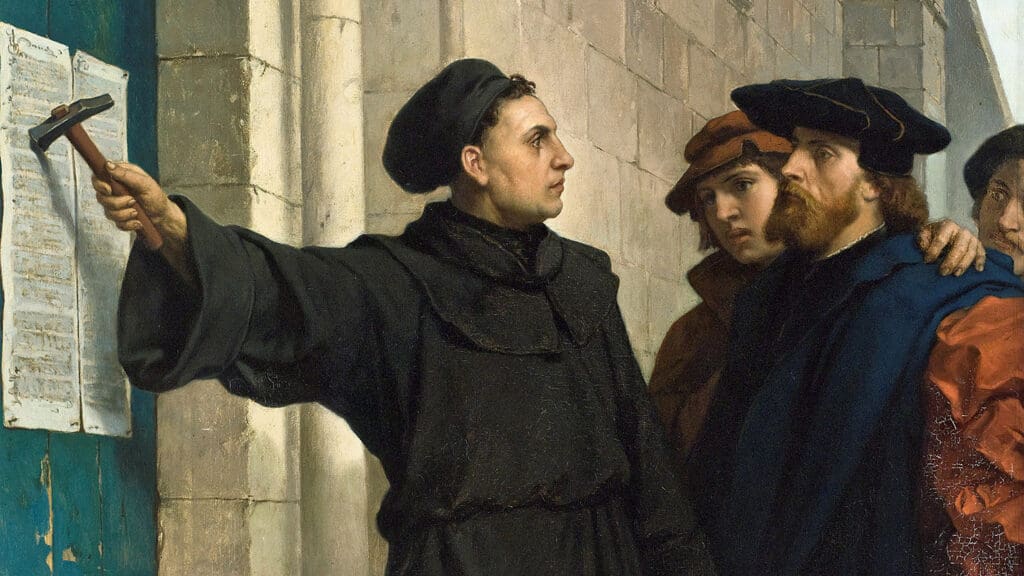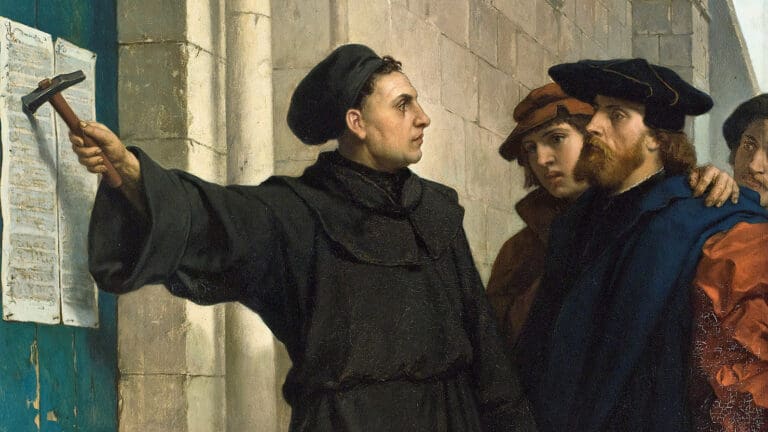Although Miklós Murányi (Menachem Meron) was an important figure in the post-Holocaust recovery and one of the leading Zionist rabbis of the transitional years, his life story remains relatively unknown. To date, no historian has written a popular article or study about his life. The following presents Murányi’s activities during the transitional years (1945–1950), with particular focus on his writings published in the bulletin edited by the Újpest Jewish community.
Murányi was born on 28 February 1921 in Szombathely. His father was Sámuel Mermelstein (later Murányi), and his mother was Fanni Neulander. He was followed by two younger brothers, Béla and Ernő. Due to financial difficulties, he was raised by his orthodox grandparents in Szombathely. He attended both cheder and yeshiva while also studying in several secular schools. After studying at the anti-Zionist yeshiva in Szombathely, he continued his education at the Miskolc yeshiva of Chief Rabbi Austerlitz, where the atmosphere was pro-Zionist.
After completing his secondary education, he enrolled in the neologist Rabbinical Seminary of Budapest and the Pázmány Péter Catholic University, where he was mentored and strongly influenced by the famous Gyula Kornis. As he later recalled, after the liberation: ‘Rabbi Ödön Kálmán gathered us together. He began by saying: “We have sinned; we misled Hungarian Jewry with our Hungarian nationalism and anti-Zionism.” Of course, this did not apply to students like me, who had absorbed Zionism and the Hebrew language with their mother’s milk.’
At the same time, he studied philosophy and psychology, earning a doctorate in the latter in 1947. However, his dissertation, The Experience of Jewish Religion in Childhood and Adolescence, was only published a year later. By that time, he had already been serving as acting deputy rabbi of the Újpest Jewish community for a year and a half.
The Jews of Újpest were deported on 11 July 1944, a total of 20 thousand people. Murányi was liberated in Bergen–Belsen, and fortunately, his wife, Éva Tisch, also survived the deportation. The young couple had married in a Budapest internment camp, with Rabbi Izsák Pfeiffer of Monor officiating—who did not return from Dachau.
The Újpest Jewish community was reestablished on 11 February 1945 by sixteen survivors, most of whom had been forced labourers. Initially, Murányi and rabbinical candidate Imre Kepecs shared rabbinical duties. Later, after Kepecs made aliyah in June 1946, the community elected Murányi as their rabbi. He was officially inaugurated on 31 October 1948, with the famous Rabbi Sándor Scheiber delivering the address, referring to him as ‘the most grateful and most loyal among my grateful and loyal students’.[1]
Under the leadership of Murányi and community president Jenő Schwartz, the Újpest Jewish community soon built a Holocaust memorial, established a local charitable home, and founded the Venetiáner Lajos School—named after Lajos Venetiáner, former chief rabbi of Újpest and historian—, where instruction was provided in both English and Hebrew. However, the state soon shut down the school, citing insufficient enrolment.

Hámori Gyula/FORTEPAN
In addition, there were active Zionist and women’s Zionist organizations, as well as the establishment of the Friedmann Dénes Cultural Circle, named after the former chief rabbi of Újpest, who was murdered in the Holocaust. Religious life quickly revived: between February 1945 and April 1948, 141 children were born, 181 weddings were held, and 48 conversions (mainly returns to Judaism) were recorded.
One of the first bar mitzvahs in the reestablished community was that of Károly Brichta, who later became Israel’s ambassador to Norway and Hungary under the name Joel Alon. The community also renovated the synagogue at 8 Beniczky Street (now Berzeviczy Gergely Street), as the synagogue at 7–11 Bocskai Street had suffered severe damage.
One of the best primary sources on Murányi’s early activities is the journal Újpesti Szabad Zsidó Élet (Free Jewish Life in Újpest), published by the congregation, for which he served as editor-in-chief. Despite its small size and irregular monthly or bimonthly publication, the journal featured surprisingly high-quality writings, including contributions from Sándor Scheiber himself.
Despite the successes achieved, Murányi published a self-critical article in one of the first issues of Újpesti Szabad Zsidó Élet, expressing his concern that the local Jewish community had already grown complacent.[2] As Murányi noted, the Jewish community had grown from 20 members in 1944 to 2,000 within three years. However, he observed: ‘paradoxical as it may sound, it is true: the more results we achieved, the more enthusiasm, self-sacrifice, and willingness to work declined. Despite the large number of nominal leaders, in reality, only a handful of truly dedicated individuals, driven by a sense of community, are keeping renewed Jewish life in motion. The rest seem to have grown tired, weary.’
The rabbi posed a hard question: ‘Where is the Jewish heart that beats for the memory of the martyrs?’ He criticized the lack of donations for the local Holocaust memorial. ‘Tempora mutantur…The external danger has passed, the binding forces that held us together from the outside have broken, and now many members of the flock are going their separate ways. But have the times really changed? Anyone who believes that they, as an individual, have no need for Jewish communal life, for a synagogue, for a memorial, for an organization that unites us all—is mistaken a hundred, a thousand times over!’
Murányi argued that those indifferent to the fate of the community were, in reality, indifferent to their own fate as well, even if they did not yet realize it.
Murányi’s argument was both compelling and bold, as he criticized the ‘assimilation’ into the emerging new system. In his article for Pesach in 1947, he recalled how, despite God leading the Jews out of Egypt, they soon began worshipping a golden calf. In a daring interpretation, he equated the golden calf with a version of ‘progress’ that also signified a turning away from Judaism—essentially condemning materialistic progressivism.
‘Murányi argued that those indifferent to the fate of the community were, in reality, indifferent to their own fate as well’
As he explained, during the Exodus, ‘only the body was freed, only the external chains of oppression were broken, but the soul remained enslaved. Even in external freedom, the inner self, emotions, and thoughts of the Jewish people remained in bondage. That generation was unfit to carry forward the Idea, to proclaim the Teaching. A new generation had to grow up during the forty years of wandering in the desert—one that had never known slavery, one that could embark on fulfilling the Jewish mission with a free soul and mind…The new generation, born in the wilderness, which knew slavery only from stories, was deemed worthy to enter the Promised Land.’
Murányi then drew a parallel to the present: ‘Now we are in the month of Nisan, 5707, and we sit at the Seder table with the terrible memory of the European “Egypt” in our hearts. This Spring Festival is no longer just about the Exodus from Mitzrayim…The feeling of freedom today does not come from the timeless tale of the Haggadah, for today, all of us who live have been liberated…Preserving our Judaism is not in conflict with the idea of progress. The new generation will show us the way—how to transform from spineless “Israelites” into self-aware Jews!’[3]
In June 1947 Rabbi Murányi reflected on the memory of the Holocaust. Despite his Zionist views, he rejected the then-popular notion that Jews had gone ‘like sheep to the slaughter’. As he argued: ‘There was no resistance—how could there have been?’ There was no one to help. Without mentioning any positive examples, he stated bluntly that the people of Újpest merely watched as ‘the Jews were taken away’. At first glance, his conclusion seemed combative: ‘Not even the purest democracy can reform those whose hands are stained with Jewish blood.’ Yet he followed this with a call to action: ‘We must trust in democracy and strengthen it with all our might—but we must never trust yesterday’s fascists.’[4] One has to add that, of course, even in Újpest, there were a brave few who rescued Jews.
When Israel was founded, the Újpest Jewish community held a grand celebration. However, Murányi had already been writing Zionist articles even earlier, when news was still focused on the UN’s plan to partition Palestine into Jewish and Arab states. In his late 1947 writings, he declared that the Jewish people’s two-thousand-year-old hope was finally coming true: ‘The people of the Bible will once again have their own land, Israel will have a voice and a rightful place among the nations…We will no longer be objects of either hatred or pity.’ Elsewhere, he wrote that there was ‘no greater or more honourable’ task for a rabbi than to welcome ‘the birth of the Third Jewish Empire’. He was adamant: ‘Anyone who calls themselves Jewish today must stand with the Jewish State! Zionism is no longer just an idea—it is the only Jewish reality!’ Murányi argued that there was no longer room for a small Zionist faction within the Jewish community because ‘the entire community itself must now function in the spirit of Zion—only this represents the true Jewish spirit.’ In 1948 the community even organized a fundraising campaign for the Israeli army.[5]
His Zionist activities soon attracted the attention of the Rákosi-era state security. As the rabbi recalled, his ‘crime’ was that he ‘acted as an intermediary between illegal émigrés and those waiting for them. They figured it out, and although I received the passport as a Zionist leader, I couldn’t use it.’ He continued: ‘The ÁVH (State Protection Authority) had been looking for me for some time, and my portrait was being circulated across the entire country. I know this because they went to my parents’ house with the wanted poster. So we left the country illegally, in great danger, crossing through the Danube into Yugoslavia. The Israeli embassy helped us; otherwise, we wouldn’t have been able to leave the country.’
‘The people of the Bible will once again have their own land, Israel will have a voice and a rightful place among the nations…We will no longer be objects of either hatred or pity’
He was certainly wanted for illegal Zionist activities by the summer of 1950, and for a while, he hid at the apartment of Scheiber Sándor. Schey György, a detained Zionist, testified that in June 1950, he and Murányi, along with the rabbi’s wife, were planning their aliyah together. The rabbi and his wife boarded an Austrian (or Russian, according to some sources) ship in Mohács, which allowed them to leave the country, though Schey himself turned back. As a result, in 1952, state security issued a surveillance file on Murányi and Tisch, but by then, they had already been in Israel for some time.[6]
Just a few days before his illegal emigration, Murányi wrote an article—one could say a farewell piece—for the Jewish journal Új Élet (New Life), in which he perhaps explained his own reasons for making aliyah: ‘Moses justifiably lost his patience here, having dedicated his entire life to his people. He felt that all his work was in vain, no matter how much he taught and laboured.’[7]
In Israel, Murányi taught Talmud, Tanach, and literature at a high school in Tel Aviv for two to three years. In 1952 he moved to Bat Yam, where he founded the city’s first high school in 1954 and taught there for 35 years. He changed his name to Menachem Meron. In 1975 he wrote a preface for the book by László Szilágyi-Windt, who documented the destruction of the Újpest Jewish community. In the preface, he quoted the Talmud: ‘The parchment may be burned, but the letters will fly away.’
However, Murányi did not escape from the Communist state security so easily. His younger brother, Béla, was also caught attempting illegal emigration and was pressured into cooperation, receiving the code name ‘Aladár Káldi’. ‘Káldi’s’ task was to emigrate to Israel and carry out intelligence duties, such as monitoring his brother, Miklós. After ‘Káldi’ emigrated, he sat down for a conversation with an undercover secret police officer at the Hungarian embassy in Tel Aviv. Although ‘Káldi’ continued to express his willingness to cooperate, it was concluded that he had no intelligence opportunities, so the connection with him was severed. In this sense, he could not indeed be considered an ‘agent’. It appears that ‘Káldi’ was never actually forced to report on his brother, although the secret service originally had such an intention. However, there remains a handwritten two-page report he wrote about his other brother, Ernő, as part of his learning process.[8]
In 1982 Murányi was able to visit Hungary again, and after the regime change of 1989, he returned several times for lectures, including in Újpest. In Israel, his son worked at the National Bank, and he was blessed with three grandchildren. In a 2000 interview, he proudly shared: ‘Our oldest grandchild, a member of the IDF, is about to receive the rank of lieutenant at the age of 23.’
In his later years, Meron received the honorary citizenship of Bat Yam, and he regularly contributed Torah commentary in the Israeli–Hungarian journal Új Kelet (New East). Starting in 1996, his thoughts were also broadcast every Friday on the Israeli Radio’s Hungarian programme.
At the end of his life, two of his books were published in Hungary: The Living Bible and The Weekly Portion Speaks to You. He passed away in October 2014. In Új Élet, the Chief Rabbi of Hungary, the late József Schweitzer, bid him farewell: ‘After a life rich in research and teaching, he passed away in his family’s company. His many friends and colleagues preserve his memory with love and great respect.’[9]
[1] Scheiber Sándor, Scheiber Sándor könyve, edited by Kőbányai János and Katona Ferenc, Múlt és Jövő Könyvek, 1994, 188.
[2] Murányi Miklós, ‘Merre visz az út?’, Újpesti Szabad Zsidó Élet, d. n. (1947), 4-5.
[3] Murányi Miklós,‘Peszachi gondolatok’, Újpesti Szabad Zsidó Élet, March 1947, Pesach issue, 1–3.
[4] Murányi Miklós, ‘Emlékezzünk!’, Újpesti Szabad Zsidó Élet, June–July 1947, 1–3.
[5] Újpesti Szabad Zsidó Élet, Aug–Sept 1947, 1–2; Újpesti Szabad Zsidó Élet, Dec 1947, 1–2; and Menáhem Meron, Az újpesti zsidó hitközség első időszaka 1945 után, Barátság 1997/1., xvii–xix.
[6] Állambiztonsági Szolgálatok Történeti Levéltára (Historical Archives of the State Security Services)(ÁBSZTL), 3.1.5. O-17169/1; and ÁBSZTL, 3.1.9. V-111885.
[7] Új Élet, 1 June 1950, 4.
[8] ÁBSZTL, I. 3.2.1., Bt-601. 225, 241–242; and ÁBSZTL, 3.2.3. Mt-483/1. 15–17.
[9] Új Élet, 1 Nov 2014, 1.
Related articles:







